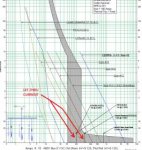Designer69
Senior Member
Hello, Please see attached image.
I have a TCC showing the coordination of some fuses and a breaker.
As can be seen, the fuses clear before the breaker so that portion is fine. But the TCC's show the let-thru current of some of the fuses is within the breaker trip region. One is even in the instantaneous region.
My question is.. does this even matter? The let-thru current may be within the breaker's trip region but wouldn't the fuses open before the breaker anyway? So I would think the let-thru current of the fuse would be irrelevant to the breaker since it's not enough time to open it.
I believe these are Current limiting fuses so let's assume that is the case.
Thank You!
I have a TCC showing the coordination of some fuses and a breaker.
As can be seen, the fuses clear before the breaker so that portion is fine. But the TCC's show the let-thru current of some of the fuses is within the breaker trip region. One is even in the instantaneous region.
My question is.. does this even matter? The let-thru current may be within the breaker's trip region but wouldn't the fuses open before the breaker anyway? So I would think the let-thru current of the fuse would be irrelevant to the breaker since it's not enough time to open it.
I believe these are Current limiting fuses so let's assume that is the case.
Thank You!


